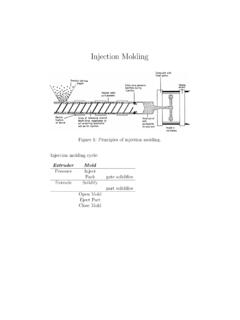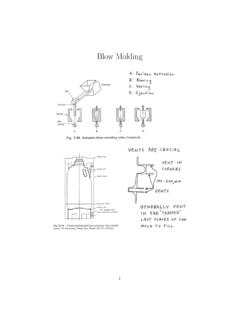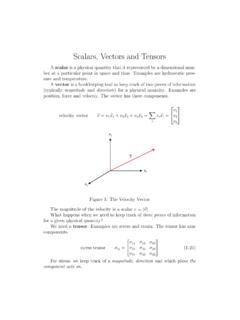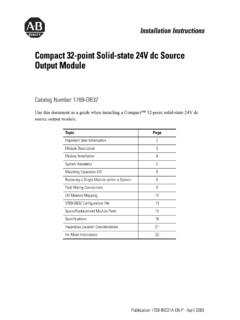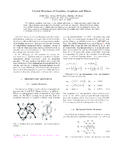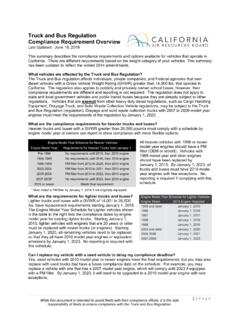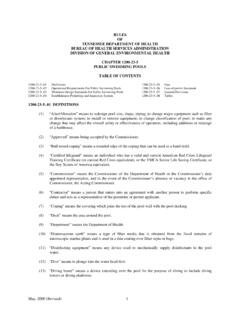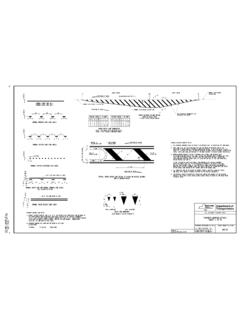Transcription of THE MAXWELL MODEL - Pennsylvania State University
1 Oversimplified Viscoelasticity THE MAXWELL MODEL . At time t = 0, suddenly deform to constant displacement Xo . The force F is the same in the spring and the dashpot. F = Ke Xe = Kv (dXv /dt) (1-20). Xe is the displacement of the spring Xv is the displacement of the dashpot Ke is the linear spring constant (ratio of force and displacement, units N/m). Kv is the linear dashpot constant (ratio of force and velocity, units Ns/m). The total displacement Xo is the sum of the two displacements (Xo is independent of time). Xo = Xe + Xv (1-21). 1. Oversimplified Viscoelasticity THE MAXWELL MODEL (p. 2). Thus: Ke (Xo Xv ) = Kv (dXv /dt) with B. C. Xv = 0 at t = 0 (1-22). (Ke /Kv )dt = dXv /(Xo Xv ). Integrate: (Ke /Kv )t = ln(Xo Xv ) + C. Apply B. C.: Xv = 0 at t = 0 means C = ln(Xo ).
2 (Ke /Kv )t = ln[(Xo Xv )/Xo ]. (Xo Xv )/Xo = exp( Ke t/Kv ). Thus: F (t) = Ke Xo exp( Ke t/Kv ) (1-23). The force from our constant stretch experiment decays exponentially with time in the MAXWELL MODEL . The relaxation time is Kv /Ke (units s). The force drops to 1/e of its initial value at the relaxation time . Initially the force is F (0) = Ke Xo , the force in the spring, but eventually the force decays to zero F ( ) = 0. 2. Oversimplified Viscoelasticity THE MAXWELL MODEL (p. 3). Constant Area A means stress (t) = F (t)/A. (0) 0 = Ke Xo /A. MAXWELL MODEL Stress Relaxation: (t) = 0 exp( t/ ). Figure 1: Stress Relaxation of a MAXWELL Element 3. Oversimplified Viscoelasticity THE MAXWELL MODEL (p. 4). A creep experiment applies constant force F (or constant stress).
3 F = Ke Xe = Kv (dXv /dt) (1-20). Thus: Xe = F/Ke and dXv /dt = F/Kv with B. C. Xv = 0 at t = 0. Integrate: Xv = F t/Kv The total displacement is Xo = Xe + Xv = F (1/Ke + t/Kv ). Strain Xo /L0. = (1 + Ke t/Kv )F/(Ke L0 ). The instantaneous strain in the spring is 0 F/(Ke L0 ) and the relax- ation time is again Kv /Ke . MAXWELL MODEL Creep: (t) = 0 (1 + t/ ). Figure 2: Creep of a MAXWELL Element 4. Oversimplified Viscoelasticity THE VOIGT MODEL . Figure 3: Voigt Element: A Spring and a Dashpot in Parallel At time t = 0, apply a constant force F. The displacement X is the same in the spring and the dashpot. The force F is the sum of forces in the spring and the dashpot. F = Ke X + Kv (dX/dt) with B. C. X = 0 at t = 0 (1-18). (Ke /Kv )dt = dX/[(F/Ke ) X].
4 Integrate: (Ke /Kv )t = ln[(F/Ke ) X] + C. Apply B. C.: X = 0 at t = 0 means C = ln(F/Ke ). (Ke /Kv )t = ln[1 XKe /F ]. 1 XKe /F = exp( Ke t/Kv ). Thus: X(t) = (F/Ke )[1 exp( Ke t/Kv )] (1-19). 5. Oversimplified Viscoelasticity THE VOIGT MODEL (p. 2). X(t) = (F/Ke )[1 exp( Ke t/Kv )] (1-19). We again have strain (t) X(t)/L0 , and relaxation time Kv /Ke . We define F/(Ke L0 ) as the long time limit of the strain. Voigt MODEL Creep: (t) = [1 exp( t/ )]. Figure 4: Creep of a Voigt Element The Voigt MODEL captures the essential physics of creep for a viscoelastic solid . 6. Oversimplified Viscoelasticity MAXWELL AND VOIGT MODELS IN SERIES. Strains of elements combined in series always add in creep. (t) = M axwell (t) + V oigt (t). (t) = 0 (1 + t/ ) + [1 exp( t/ )].
5 Figure 5: MAXWELL and Voigt Elements in Series and their Strain in Creep MAXWELL and Voigt Elements in Series capture the essential physics of creep for a viscoelastic liquid. 7. Rheological Terminology THE JARGON OF STRANGE FLUIDS. Dilatancy n. Increase in apparent viscosity with shear rate (also shear- thickening). Rare, but seen in some solutions of associating polymers. Rheopexy n. Apparent viscosity increases with time at a given rate (also anti-thixotropy or structure-building). Rare, but seen in some suspensions. Thixotropy n. Apparent viscosity decreases with time at a given rate (also structure-breaking). Common for concentrated suspensions. Figure 6: Thixotropic behavior of a structured fluid. Shear-thinning n. Decrease in apparent viscosity with shear rate.
6 Very important for nearly all polymers and suspensions. Yield Stress n. The stress required for a structured fluid to flow (also Bingham stress). Common for concentrated suspensions and liquid crys- tals. 8. Yield Stress THE BINGHAM MODEL . Structured fluids, such as concentrated suspensions and liquid crystals show solid rheological response at low stress levels. The simplest MODEL for this class of flow is the Bingham MODEL .. G < 0. = (1-24). 0 + p > 0. 0 is the yield stress, below which there is no flow, and above which flow occurs with 0 of the stress being used to maintain the liquid response, and the remainder ( p ) causing simple Newtonian flow. Figure 7: Flow Curve of a Bingham Plastic compared to Newtonian and shear-thinning fluids.
7 Flexible polymer melts and solutions are either Newtonian ( = ) or shear-thinning (meaning that the apparent viscosity decreases with shear rate) but do NOT have a yield stress. 9. Origins of Elasticity in Polymer Liquids The configuration of a polymer chain in a melt is a random walk because it maximizes configurational entropy. Flow Field = Stretch Chain = Lower Entropy Configuration Figure 8: By stretching the chain, the number of configurations is reduced, which decreases the entropy (and requires work). Using Statistical Mechanics, it is easy to show that the chain actually behaves like a linear spring. The (entropic) free energy G is quadratic in the end-to-end distance R. 3kT R2. G=. 2N b2. k is Boltzmann's constant T is absolute temperature N is the number of monomers in the chain b is the monomer size In the upstretched State R2 = N b2 , and the configurational free energy is 3kT /2.
8 The force required to stretch the chain is G 3kT R. F = =. R N b2. This is precisely why a rubber band behaves like a linear spring. 10.

